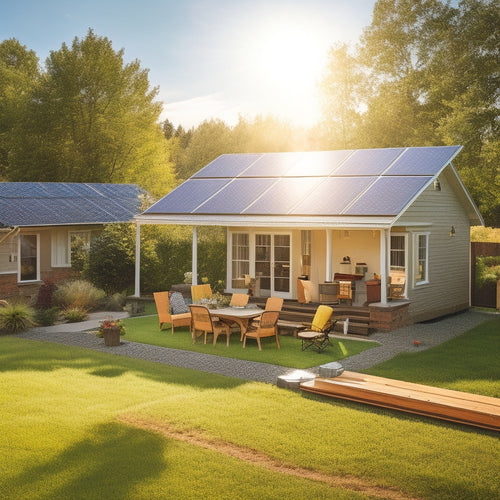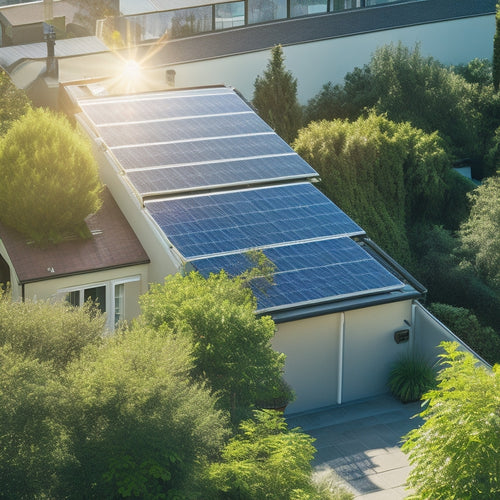
Affordable Solar Panel Options for Household Energy
Share
You can install an affordable solar panel system for your household energy needs with prices starting as low as $2.50 per watt for budget-friendly options like Trina Solar, while still benefiting from long-term savings and energy independence. With various types of solar panels available, such as monocrystalline, polycrystalline, and thin-film, you can choose the one that suits your roof space and budget. By understanding the cost-benefit analysis, you'll see how solar energy can save you up to $1,000 per year on electricity bills. Additionally, exploring top affordable solar brands, DIY installation, and government incentives can help you make an informed decision - and that's just the beginning of your expedition to utilizing clean energy.
Key Takeaways
- Monocrystalline solar panels offer high efficiency, but at a higher cost, while polycrystalline panels are more affordable with slightly lower efficiency.
- DIY solar panel installation can save thousands by bypassing contractor markups, but requires time and research for a successful installation.
- Top affordable solar brands like Trina Solar, Canadian Solar, and Hanwha Q CELLS offer high-quality panels at competitive prices.
- Government incentives such as the Federal Tax Credit and state rebates can significantly reduce the upfront cost of solar panel installation.
- Combining solar panels with energy-efficient practices and appliances maximizes energy savings and reduces carbon footprint.
Solar Panel Types for Home
As you consider shifting to renewable energy, selecting the right solar panel type for your home becomes an essential decision.
You'll want to choose a panel that balances efficiency with installation practicality. Monocrystalline silicon panels offer high solar panel efficiency, typically above 20%, making them ideal for homes with limited roof space.
However, their higher cost and installation challenges may deter some homeowners.
Polycrystalline silicon panels, on the other hand, provide a more affordable option with efficiencies ranging from 15% to 18%.
While their lower efficiency may require more panels to achieve the same energy output, their ease of installation and lower upfront cost make them an attractive choice for many homeowners.
Thin-film solar panels offer a more flexible and lightweight option, suitable for homes with complex or curved rooflines.
Although their efficiencies are generally lower, around 7-14%, their installation challenges are often fewer, making them a viable option for homes with unique design features.
Cost-Benefit Analysis of Solar
You're likely considering solar panels for their environmental benefits and potential savings, but you'll need to crunch some numbers to determine if they're a sound investment for your home.
A thorough cost-benefit analysis involves breaking down the upfront costs, evaluating the long-term savings potential, and assigning a value to the energy independence they provide.
Upfront Cost Breakdown
When considering a solar panel installation, one of the primary concerns is the upfront cost, which can be a significant barrier to entry for many homeowners. While the initial investment may seem overwhelming, understanding the breakdown of costs can help you make an informed decision.
Here is a general breakdown of the upfront costs you can expect to pay:
| Cost Component | Average Cost | Percentage of Total |
|---|---|---|
| Installation Expenses | $10,000 - $15,000 | 60% - 70% |
| Equipment Costs (Panels, Inverters, etc.) | $5,000 - $8,000 | 30% - 40% |
| Permitting and Inspection Fees | $1,000 - $2,000 | 5% - 10% |
| Financing Options (Interest, etc.) | $1,000 - $3,000 | 5% - 15% |
| Miscellaneous (Mounting, Wiring, etc.) | $1,000 - $2,000 | 5% - 10% |
Keep in mind that these are general estimates, and your specific costs may vary depending on your location, system size, and other factors. Understanding these costs will help you make a more informed decision about whether solar power is right for you.
Long-Term Savings Potential
Nearly every homeowner who installs solar panels can expect to reap considerable long-term savings. By utilizing renewable energy from the sun, you'll reduce your reliance on the grid and lower your electricity bills. Over time, these savings can add up to substantial lifetime savings.
A typical residential solar panel system can save you between $400 and $1,000 per year on your electricity bills, depending on your energy usage and local utility rates. With an average system lifespan of 25 years or more, your total lifetime savings could exceed $10,000 to $25,000.
Additionally, as electricity rates rise over time, your savings will increase, providing a hedge against inflation.
When viewed as an investment, solar panels offer attractive returns. With federal and state incentives, your initial investment can be markedly reduced.
Furthermore, solar panels can increase your property value, providing a potential long-term return on investment of 10% to 15% or more. By installing solar panels, you're not only reducing your energy bills but also generating a strong investment return.
Energy Independence Value
Your solar panel system's energy independence value is an essential aspect of its cost-benefit analysis. This value represents the degree to which you can reduce your reliance on the grid and enjoy energy autonomy. By utilizing renewable resources like sunlight, you can generate your own electricity and decrease your dependence on fossil fuels.
When evaluating the energy independence value of your solar panel system, you should consider factors such as the system's capacity, your energy consumption patterns, and the local grid's reliability. A higher energy independence value indicates that your system can meet a larger portion of your energy needs, reducing your exposure to price fluctuations and supply disruptions.
Moreover, energy independence value can be quantified by analyzing the amount of energy your system produces versus the amount you consume from the grid. A higher ratio of self-generated energy to grid-purchased energy translates to greater energy autonomy and reduced reliance on non-renewable resources.
Top Affordable Solar Brands
You're likely looking for solar brands that offer the best bang for your buck.
When it comes to affordable solar panels, you'll want to contemplate the best budget options that meet your energy needs without breaking the bank.
Let's examine the top value picks that balance quality and affordability.
Best Budget Options
Switching to solar energy can be an intimidating task, especially when considering the upfront costs. However, there are budget-friendly options available that can help you shift to clean energy without breaking the bank. You can opt for solar panel financing, which allows you to pay for your system over time, or consider community solar programs that enable you to share the benefits of solar energy with your neighbors.
Here are some of the best budget options for you:
| Brand | Price Range |
|---|---|
| Trina Solar | $2.50 - $3.50 per watt |
| Canadian Solar | $2.60 - $3.60 per watt |
| Hanwha Q CELLS | $2.70 - $3.70 per watt |
| Jinko Solar | $2.80 - $3.80 per watt |
These brands offer high-quality solar panels at an affordable price point, making them an excellent choice for those on a budget. Keep in mind that prices may vary depending on the specific model, installation costs, and other factors. Be sure to research and compare prices to find the best option for your energy needs.
Top Value Picks
In the domain of affordable solar energy, finding the perfect balance between quality and cost can be a challenge. You need solar panels that deliver high solar panel efficiency without breaking the bank.
After researching the market, you'll find that top value picks offer the best of both worlds. Renewable energy sources like solar power are becoming increasingly popular, and for good reason.
Top brands like Trina, Hanwha Q CELLS, and Jinko Solar offer high-efficiency solar panels at an affordable price point. These brands have optimized their manufacturing processes to minimize costs without sacrificing performance. You can expect efficiencies ranging from 18% to 20% from these top value picks.
When choosing a top value pick, consider factors like warranty, durability, and certifications. Look for brands that offer a 25-year warranty and are certified by reputable organizations like UL and IEC.
DIY Solar Panel Installation
With DIY solar panel installation, homeowners can bypass contractor markups and save thousands of dollars on their solar panel system. By taking on the installation process yourself, you'll need to invest time in researching and preparing for the job.
Start by selecting suitable solar panel materials, including high-efficiency panels, mounting hardware, and electrical connections. Confirm you have the necessary installation tools, such as a drill, wire stripper, and circuit tester.
Before beginning the installation, assess your roof's structural integrity and determine the best panel layout. Familiarize yourself with local building codes and obtain any required permits.
During installation, follow safety guidelines and take necessary precautions when working at heights and with electrical systems. While DIY installation requires more effort, it can be a cost-effective way to shift to renewable energy.
With careful planning and execution, you can successfully install your solar panel system and start generating clean energy for your home.
Government Incentives for Solar
By leveraging government incentives for solar, you can greatly reduce the upfront cost of your solar panel system. The government offers various incentives to encourage the adoption of renewable energy sources, and solar power is no exception.
| Incentive Type | Description | Benefits |
|---|---|---|
| Federal Tax Credit | 26% tax credit for solar panel installation | Reduces federal income tax liability |
| State and Local Rebates | Varying rebate amounts for solar panel installation | Direct cash incentives for solar adoption |
| Installation Grants | Grants for solar panel installation, especially for low-income households | Financial assistance for underserved communities |
| Financing Options | Low-interest loans and financing options for solar panel installation | Increases accessibility to solar energy |
These incentives can greatly reduce the financial burden of installing solar panels. Additionally, many states and local governments offer their own green incentives, such as property tax exemptions and sales tax exemptions, to encourage the adoption of renewable energy. By taking advantage of these incentives, you can enjoy the environmental benefits of solar energy while also saving money on your energy bills.
Energy Efficiency and Solar
Your home's energy efficiency plays a significant role in maximizing the benefits of your solar panel system. By reducing your energy consumption, you can optimize the performance of your solar panels and increase your energy independence.
This means investing in energy conservation measures such as insulation, energy-efficient appliances, and smart home devices.
By doing so, you can reduce your energy consumption and rely more heavily on renewable resources like solar power. This not only reduces your carbon footprint but also saves you money on your energy bills.
A well-designed solar panel system can provide up to 100% of your energy needs, but only if your home is optimized for energy efficiency.
Maintenance and Warranty Options
Optimizing your home's energy efficiency is just the first step in utilizing the full potential of solar power. To guarantee your solar panel system continues to perform at its best, it's important to reflect on maintenance and warranty options.
Regular maintenance is vital to extend the lifespan of your solar panels and maximize energy production. Here are some maintenance tips to keep in mind:
- Inspect your solar panels regularly for debris, dirt, or damage
- Clean your solar panels every 6-12 months to guarantee peak energy absorption
- Check your system's performance monitoring to identify any potential issues
- Trim trees or shrubs that may be shading your solar panels
- Think about hiring a professional to perform annual maintenance checks
When comparing warranty options, look for providers that offer extensive coverage for parts, labor, and performance.
A good warranty should cover you for at least 25 years, with some providers offering up to 30 years of coverage. Be sure to read the fine print and understand what's included in your warranty before making a purchase.
Frequently Asked Questions
Can I Install Solar Panels on a Rented Property?
You'll need to negotiate solar panel agreements with your landlord, ensuring you understand the terms and renter incentives, such as who'll own the system and who'll benefit from the energy savings.
Do Solar Panels Work During Power Outages?
You're stuck in the dark, literally, during power outages, but solar panels can be your knight in shining armor! With solar battery storage, you'll stay lit, but grid-tied systems won't cut it - they'll shut down for safety reasons, leaving you in the dark.
Are Solar Panels Affected by Weather Conditions?
You'll find that solar panels are indeed affected by weather conditions, with cloud cover, temperature, and humidity impacting solar panel efficiency. Clear skies yield maximum output, while shade and extreme temperatures reduce performance, so you'll need to take into account your local weather impact.
Can I Use Solar Panels for Heating Water?
You can utilize solar energy to heat water using solar water heating systems, which integrate solar panels with a storage tank, providing a cost-effective and eco-friendly alternative to traditional heating methods, perfect for your household needs.
Do Solar Panels Increase Property Value?
You think solar panels are just for saving the planet, but surprise! They're also a savvy investment, enhancing your property resale value by up to 17%. Enjoy the solar panel benefits, and reap the rewards when you sell.
Conclusion
As you weigh your options for affordable solar panel solutions, remember that investing in renewable energy can pay off in the long run. Did you know that a typical American family can save up to $500 per year on their electricity bills by switching to solar power? With the right combination of cost-effective panels, DIY installation, and government incentives, you can utilize the power of the sun to fuel your home while reducing your carbon footprint.
Related Posts
-

Steps to Prepare for Solar Installation
To prepare for solar installation, start by evaluating your current energy consumption and future needs to determine ...
-

How Solar Panels Reduce Electricity Bills
Solar panels can drastically cut your electricity bills by utilizing sunlight to generate your own energy. This decre...
-

Solar Power Advantages for Rural Communities
Solar power presents numerous advantages for rural communities. You can greatly reduce energy costs, potentially by u...


